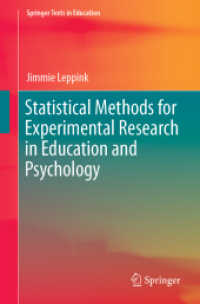- ホーム
- > 洋書
- > 英文書
- > Science / Mathematics
Full Description
ASTRONOMICAL ECLIPSE PHENOMENA In looking over the long history of human science from time immemorial to our own times, it is impossible to overestimate the role played in it by the phenomena of eclipses of the celestial bodies-both within our solar system as well as in the stellar universe at large. Not later than in the 4th century B. C. , the observed features of the shadow cast on the Moon by the Earth during eclipses led Aristotle (384-322 B. C. ) to formulate the first scientific proof worthy of that name of the spherical shape of the Earth; and only somewhat later, the eclipses of the Sun provided Aristarchos (in the early part of the 3rd century B. C. ) or Hipparchos (2nd half ofthe same century) with the geometric means to ascertain the distance which separates the Earth from the Sun. In the 17th century A. D. (in 1676, to be exact) the timings of the eclipses of the satellites of Jupiter by their central planet enabled Olaf Romer to discover that the velocity with which light propagates through space is finite.
Contents
List of Contents.- I. Introduction.- II. Light Changes Due to Eclipses of Spherical Stars.- II.1 Loss of Light: Eclipse Functions.- II.2 Recursion Properties of Eclipse Functions.- II.3 Differential Properties of Eclipse Functions.- II.4 Bibliographical Notes.- III. Loss of Light as Integral Transforms.- III.1 Beam Cross-Correlation: Fourier Transform.- III.2 Hankel Transforms and Their Evaluation.- III.3 Differential Properties of Hankel Transforms.- III.4 Fourier Transforms and Their Inversion.- III.5 Radial Velocities: Rotational Effect.- III.6 Bibliographical Notes.- IV. Theoretical Photometry of Distorted Eclipsing Systems.- IV.1 Theoretical Light Changes: Transformation of Coordinates.- IV.2 Effects Arising from Distortion of the Eclipsing Star.- IV.3 Effects Arising from Distortion of the Eclipsed Star.- IV.4 Eclipses of Oscillating Stars.- IV.5 Bibliographical Notes.- V. Inverse Problem: Solution for Elements of the Eclipses.- V.1 Moments of the Light Curves: Spherical Case.- V.2 Moments of the Light Curves: General Properties.- V.3 Inversion of the Moments: Spherical Stars.- V.4 Moments of the Light Curves: Determination from the Observations.- V.5 Bibliographical Notes.- VI. Inverse Problem for Distorted Eclipsing Systems.- VI.1 Variation of Light between Eclipses.- VI.2 Modulation of the Light Curves.- VI.3 Photometric Perturbations Arising from Distortion of the Eclipsing Star.- VI.4 Effects Caused by Distortion of the Star Undergoing Eclipse.- VI.5 Bibliographical Notes.- VII. Laboratory Simulations.- VII.1 Analog Computers: Will Digital Computation Survive?.- References.








